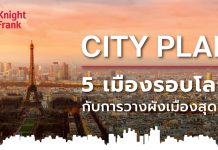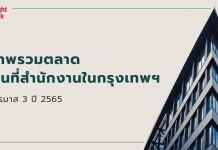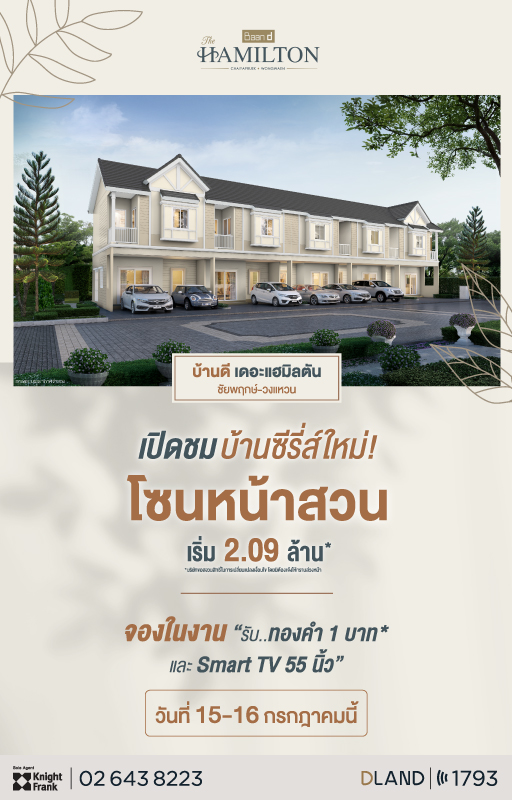It has been over a month since Thailand announced the state of emergency to combat the coronavirus disease 2019 (COVID-19). The global pandemic has created disruptions to the Thai economy to the extent that the Bank of Thailand has had to revise the previous 2.8% GDP growth projection to a 5.3% contraction for 2020. We are seeing a variety of ways in which different organizations are responding to the crisis as part of the largest workplace experiment conducted to date.
Some companies are shuffling their staff, rotating their employees between entering the office and working from home schedules. Others have their entire staff working from home. This has radically impacted the way in which both organizations and employees work, especially in a country with a relatively high level of resistance to prior changes in the workplace. It has also led to many questions and judgements on the long-term impact that COVID-19 will have on the office property market, including those that radically proclaim the demise of the office.
The following dynamics are what we at Knight Frank and Peoplespace Thailand believe will shape the workplace as a result of COVID-19. COVID-19 most likely will not completely revolutionize or cause the death of the office. While the pandemic will lead to greater scrutiny and change in some prior market behavior, its most profound impact will be to drive and accelerate trends that were already underway for many of the leading office market participants.
Corporate Level Dynamics
Corporate attitudes toward real estate will be greatly varied across sectors and companies, with this being highly dependent on their financial resilience during and after COVID-19. Some companies will view real estate as a costly capital and operating expense that needs to be reduced in order to ensure survival, while others will emerge with the goal of utilizing real estate to support their greater sense of purpose and responsibility towards their employees and other stakeholders. A growing concern for environmental sustainability and corporate pledge to reduce carbon footprint will continue its trajectory. More corporates will aim to achieve such targets via real estate through efficient and environmentally friendly building design, construction, occupancy and management practices.
Market Level Dynamics
Great quantity, low quality characterizes immediate supply.
Prior to COVID-19, the Bangkok office market was characterized by a continued flight to high-quality workspaces. Market growth was driven by an increasing number of occupiers who recognized that office space can be used to enhance their work productivity and who were willing to spend more to accomplish it.
Post COVID-19, the market will likely be characterized by a distinct divide in how occupiers view and utilize their real estate. Companies in sectors severely affected by the pandemic, such as those in traditional retail, tourism, transportation and accommodations, may be forced into survival mode as financial pressures mount. Some companies that elect to cut operating costs may decrease their real estate expenses either by surrendering some space back to the landlord, seeking sub-tenants or by relocating to a different property. Firms that opt to relocate will generate some demand for competitively priced buildings that can persist if they fail to recover to pre-crisis levels.
However, given that relocation itself is a costly capital expenditure, space reduction is likely to be the preferred option for most occupiers. Even without financial struggles, some firms may choose to reduce space by adopting more efficient office layouts and implementing activity-based working or agile working policies. On the other hand, companies that recover or even emerge stronger from the crisis, such as those in e-commerce, healthcare and technology sectors, will strive to continue investing in high-quality real estate. However, the definition of ‘quality’ will no longer be based purely on the physical properties of the building, but also nuanced by soft services related to health, safety and wellbeing.
The customer as king becomes a reality
Over the past decade, the office market was landlord-favored, resulting in rental growth of around 5% annually. In 2019, we saw some signs of this growth waning as supply began to outpace demand. COVID-19 continues to stress underlying weaknesses in the market, accelerating the shift towards a more balanced or even tenant-favored market. A demand profile that places greater value on the experiences generated by the property and its landlord, especially in the areas of health and safety, will become more prominent. Combined with the relatively large supply pipeline, there will be increased competition for landlords to attract tenants. In order to secure and retain rental income, it won’t be enough for a developer to simply deliver a physically sound building in a relatively accessible location. This will lead to a greater variation in the performance of ‘prime’ properties, with those tailored to align with customer needs outperforming generic grade A buildings in both rents and occupancy.
We are already starting to see some new projects that are being developed with the creation of positive tenant experiences in mind. For example, the mega mixed-use project One Bangkok is targeting a LEED platinum-certified neighborhood status and will utilize technologies like smart parking and centralized security systems. Meanwhile, 111 Praditmanutham building will provide a range of amenities from meeting rooms to a fitness center to all tenants free of charge. Lastly, CAS Centre will implement PM2.5 air filters, private bathrooms and have a dedicated floor for health & wellbeing services.
Flex in demand but delivered differently
Although flexible office space has boomed over the past decade, it currently only represents a small proportion of the Bangkok office market. Most of the flexible space is delivered by co-working operators that emphasize a highly sociable environment. Many of the spaces provided have multiple companies operating side by side on an open floorplate.
The success of this model is called into question in the immediate post-pandemic market environment given the need for continued social distancing measures. However, theCovid-19 crisis will likely not dampen the demand for flexible workspace. Rather, demand will be transformed in favor of serviced, flexible or managed offices over traditional co-working models. This is because serviced offices offer a combination of flexibility and self-contained space that will be much better suited for health-conscious occupiers. Meanwhile, we will see a big reduction over the near-term in offerings that increase social contact such as shared workspaces and hot desks.
Polarization in value (and pricing)
As experiences and soft services are expected to increase in value to occupiers, greater transparency on service charges will help landlords justify the pricing for such provisions. Currently, service charges in lease agreements help minimize property tax liability, but rarely reflect the true costs of operating an office building. However, the new property tax law amendment in 2020 will change the tax calculation method from a fixed tax as a percentage of rent to marginal tax on government appraised property value. As rents are no longer a factor in tax calculation, there is less incentive to structure leases in this manner. With this shift in dynamics already in progress, can COVID-19 be a catalyst to greater lease transparency and make it worthwhile to reconsider the longstanding way that office rents are priced?
Office Building Level Dynamics
Better but more dispersed space
Prior to COVID-19, many companies consolidated their workspace under one roof to foster a collaborative culture, to boost productivity and to, from a market perspective, increase their bargaining power in negotiations with landlords. COVID-19 has proven to us that such workplace strategies are insufficient in the face of health-related crises. During this pandemic, we have discovered that Business Continuity Plans (BCP) focused on one-roof, wider floorplates or connected floors for one organization can be ineffective and face several challenges from the risk management and business continuity perspective. Dispersing an organization’s workspace across multiple locations or satellite offices might be one of the best solutions to minimizing disruptions caused when some office buildings are locked down due to the risk of viral infections. At the very least, this can help to reduce office density and risks of outbreaks within organizations.
Over 75% of employees working in Bangkok commute to the CBD via public transport such as the BTS or MRT, which are considered to create high risks of infection. For this reason, there might be an increase in the number of people traveling to and from work via personal transport. Consequently, this will lead to other issues such as parking space shortages and increased traffic congestion in inner Bangkok. Despite the already high level of congestion in the city, total supply of office space in Bangkok is projected to increase by around 1.2 million square meters by 2023. This is over a 20% increase from current levels. Increased traffic issues in the inner city and the need for dispersed workspaces can increase demand for office buildings located outside the CBD. To take full advantage of the arising opportunity, landlords of such properties should reconsider and strategize ways to retrofit or upgrade their facilities.
Office as a choice, not an obligation
Many organizations, whether willingly or not, are adopting working from home (WFH) policies to minimize disruptions. Many have come to realize that remote working is currently accepted and can be successfully implemented in Thailand, which contrasts with prior negative preconceptions they may have had. From the ‘Work + life during COVID-19 Impact’ Peoplespace survey data collected from 510 employees across 250+ companies in Thailand, it was found that 44% of respondents would like 2-3 days of remote working per week under normal conditions, compared to 26% who did not want any remote work at all. The Peoplespace survey also showed that 37% of respondents agreed that their organization needs to implement a new workplace strategy or change the working style, with 26% wanting to be more flexible and mobilized while working.
For many, it indicates that under certain circumstances, the office will become a choice, not an obligation. If working in the office every day is no longer mandatory for all employees, then assigned desks can be significantly reduced and the choice of different future work settings can arise. It is a good opportunity for organizations to engage in workplace strategy and re-evaluate and potentially replace outdated occupancy models in a post COVID-19 setting. Some may consider transforming their office from a headcount-based workplace into an activity-based workplace (AWB). If deemed appropriate to do so, they can potentially save up to 30%-50% of space. More importantly perhaps, occupiers can create spaces that fully enable the collaboration, innovation and socialization that will be so important to corporate culture and competitiveness in the post COVID-19 operating environment.
Emphasis on experience, not environment
It has always been difficult to make budget allocation decisions in workplace strategy and design projects when faced with the choice between physical aesthetics and soft services. This choice can have a significant impact on employees’ experiences in the workplace and their productivity. In most cases, companies prioritize physical aspects over services, aiming to create a “wow-factor.” However, given changes brought about by COVID-19, companies should reconsider how best they can invest in their workspace. If the office does become a choice and not an obligation, then companies that require employees to be in the office with reasonable regularity will need to create an environment and experience to attract people into the office. Currently, only around 26% of employees we surveyed are entering the office either full time or partially, and perhaps, this may continue for some time. When they do return, more employees will be concerned about they interact and engage with their colleagues and customers, rather than the appearance of the workplace.
The holistic journey design following the COVID-19 experience will need to be to be uplifted and redesigned to meet post-crisis requirements. This means applying a data-driven design strategy that will augment employees’ experiences and meet their day to day needs with appropriate support services and facilities. A number of companies have started to re-board employees to the office building and workplace. It is imperative that they start to engage in workplace strategy and facility management (FM) before and during this transition phase.
Health, safety & wellbeing key to the experience
Occupational health, safety and well-being are not newfound factors to the office experience, having been introduced over the past few decades. Unfortunately, they were often treated as low-priority objectives for many organizations prior to the crisis. Often companies focused instead on creating experiences that were entertaining via office toys like ping-pong tables and gaming stations, or fun furniture like hammocks, grass flooring, and igloo meeting rooms. Post-crisis, it will no longer be acceptable to focus on entertaining experiences at the expense of health, safety & well-being. These factors will now increase in importance for companies that want to attract and retain employees.
Essentially, COVID-19 has created health risks for employees and their families and heightened their concern about such issues. Employees will want to be productive in the workplace and feel secure about their health, safety and well-being at the same time.
Meanwhile, employers will have a greater moral responsibility to ensure that their workplace well-being policies and facilities meet the needs of their employees. There may also be a greater regulatory obligation as well. The Thai Ministry of Labour has already instructed that all organizations must provide a safe workplace environment for employees to conduct their work. Prior health and safety measures may no longer be enough to satisfy the regulatory framework in a post-pandemic setting. Hygiene guidelines and provisions including physical distancing, alcohol hand sanitizers and cleaning services and longer term building technology such as temperature scanners or holographic keypad entry can consequently create “trust” between landlords, tenants and their employees beyond the post-COVID experience.
Uncertain Future, Certain Time for Action
In reality, it is too early to conclude with much certainty what the post-crisis market will look like, and how long it will take to get there. We are facing an unprecedented situation that continues to evolve daily. The dynamics introduced do not provide absolute conclusions about the long-term impact on the Bangkok office market, but demonstrate what we understand with relative certainty given our research findings and sustained active engagement with clients. Much of the current literature surrounding COVID-19 and the office presents the future of the office market as a singular destination with a linear journey towards it. In reality, the future will vary from organization to organization, sector to sector and country to country. The varied futures will likely be shaped by the inter-play between the various dynamics and the local setting.
Although we are entering uncharted territory, there is one thing that can be said with certainty: neither landlords nor tenants can adopt a “business as usual” attitude to their real estate and reasonably expect the same level of performance achieved prior to COVID-19, whether it be employee retention or sustained rental income. Ensuring that post-crisis needs are properly understood and met via BCP, workplace strategy and design, facility management, capital improvements and soft services will be key to success going forward.
Knight Frank and Peoplespace Thailand have developed research materials that provide further insights on the COVID-19 impact on markets around the world and offer some practical advice on how tenants can begin to look at reoccupying their office space as we begin to emerge on the other side of this global crisis. Some of the available materials can be accessed via the following link: https://www.knightfrank.co.uk/research/covid-19














